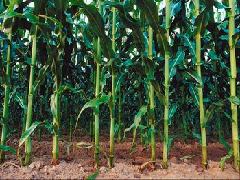Features
Process and field-scale ethanol yield of five lignocellulosic feedstocks
Date: 2018-11-15 14:00:30.0
Author: GLBRC
 Evidence suggests that biorefineries can accept a variety of feedstocks without negatively impacting field-scale ethanol yields
Evidence suggests that biorefineries can accept a variety of feedstocks without negatively impacting field-scale ethanol yields
The Science
GLBRC researchers processed and experimentally quantified ethanol production from five different herbaceous feedstocks: two annuals (corn stover and energy sorghum) and three perennials (switchgrass, miscanthus, and restored prairie). They determined that a range of plant types could be used in a lignocellulosic ethanol refinery without having a major impact on field-scale ethanol yield, which represents the ethanol production per land area.
The Impact
Lignocellulosic biorefineries are currently designed around a model where one, or sometimes two, feedstocks are grown and harvested nearby, then processed and fermented into biofuels or bioproducts. However, accepting a variety of feedstocks could improve the environmental footprint of the facility; biorefinery economics; and harvest, storage, and transportation logistics. By examining both the process ethanol yield (efficiency of microbes during fermentation) and field-scale ethanol yield (ethanol production per land area), GLBRC scientists were able to determine that a lignocellulosic refinery could be relatively feedstock agnostic in terms of what materials are accepted and processed.
Summary
In this study, GLBRC scientists investigated how five different feedstocks affected process and field-scale ethanol yields. Two annual crops (corn stover and energy sorghum) and three perennial crops (switchgrass, miscanthus, and restored prairie) were pretreated using ammonia fiber expansion (AFEX), hydrolyzed, and fermented separately using yeast (Saccharomyces cerevisiae Y128) or bacteria (Zymomonas mobilis 8b). They found that while both biomass quality (chemical composition, moisture content, etc.) and biomass yield affected field-scale ethanol yield, biomass quality was the main driver for the ethanol yields for high-yielding crops and biomass yield was the main driver for the ethanol yields for low‐productivity crops. Therefore, to increase ethanol yield for high-yielding crops, it may be prudent to focus efforts on improving biomass quality or conversion efficiency, whereas for low-yielding crops, focusing on increasing biomass yield may be the best strategy. For process ethanol yields, most feedstocks fell within a similar range, especially when Z. mobilis 8b was used. In total, the results of this study suggest that a variety of feedstocks with a range of quality can be used in a lignocellulosic refinery without a major negative impact on field-scale ethanol yields.
About The Great Lakes Bioenergy Research Center
The Great Lakes Bioenergy Research Center (GLBRC) is a U.S. Department of Energy-funded Bioenergy Research Center led by the University of Wisconsin–Madison. With Michigan State University and other partners, we are developing sustainable biofuels and bioproducts made from dedicated energy crops grown on marginal lands. Our mission is simple: creating biofuels and bioproducts that are economically viable and environmentally sustainable.
For further information about The Great Lakes Bioenergy Research Center, please visit the website here.
Displaying 2 keywords used to tag this article:
- New Balance 578 :
- Replica Omega New
